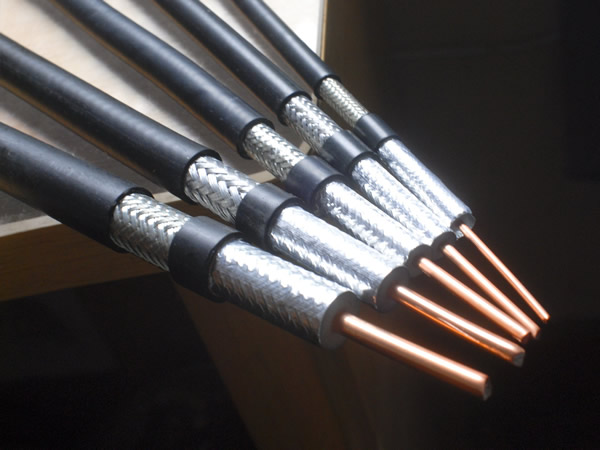

Déanann cáblaí comhaiseach sruth ailtéarnach ailtéarnach seachas sruth díreach díreach, rud a chiallaíonn go n -aisiompaíonn treo na srutha arís agus arís eile in aghaidh an tsoicind.
Is éard is cábla comhaiseach ann ná líne tarchuir sreinge agus comhartha, De ghnáth is cúis le ceithre shraith d'ábhar.
Is é an t -óstach ná sreang chopair seoltaí, agus tá sraith plaisteach mórthimpeall air ag an taobh amuigh den líne, Is inslitheoir agus úsáid tréleictreach é.
Inslitheoir taobh amuigh agus ciseal tanaí de chorp seoltaí mogalra, copar nó cóimhiotal go ginearálta.
Ansin is é an corp seoltaí taobh amuigh an ciseal is forimeallaí d'ábhar inslithe mar an craiceann seachtrach.
Is féidir cáblaí comhaiseach a úsáid chun comharthaí aschur agus digiteacha a tharchur le haghaidh réimse leathan feidhmeanna, Is é an ceann is tábhachtaí a tharchur teilifíse cábla. Tarchur teileafóin fad-achair, Naisc ghearr-achair idir córais ríomhaireachta, agus líonraí ceantair áitiúil.
Comhaiseach sreang cábla ag forbairt go tapa mar bhealach chun comharthaí teilifíse a dháileadh ar na mílte teach, ar teilifís cábla é. Is féidir córas teilifíse cábla a luchtú le mórán nó fiú na céadta cainéal teilifíse, agus is féidir a raon tarchuir a bhaint amach deich gciliméadar.
De ghnáth roinntear cáblaí comhaiseach sa dá chatagóir seo a leanas, Ag brath ar a ról struchtúrach:
Sciath an Baseband sreang chábla comhaiseach de ghnáth is struchtúr mogalra é atá déanta as copar le bacainní sainiúla de 50 Ó.
Úsáidtear an cábla seo chun comharthaí digiteacha a tharchur agus is iondúil go mbíonn sé ar fáil i gcábla tiubh RG-8 agus cábla tanaí RG-58.
Is é an difríocht is iomaíche idir cáblaí garbh agus cáblaí fíneáil an difríocht i dtrastomhas cábla.
An corda comhaiseach tá sé oiriúnach do líonraí áitiúla níos mó, Tá achar fada caighdeánach agus iontaofacht ard aige.
ach, Caithfear líonraí cábla garbh a shuiteáil le cábla transceiver agus transceiver, Tá sé deacair an tsuiteáil a dhéanamh freisin. Mar sin tá an costas foriomlán ard. I gcodarsnacht, Tá an cábla tanaí níos simplí agus níos saoire.
ach, Toisc go gcaithfear an cábla a ghearradh as le linn na suiteála, tá seans maith ann go mbeidh droch -theagmháil ann nuair a bhíonn go leor cónaisc ann.
Cibé an bhfuil an líonra ceangailte ag úsáid cáblaí tiubha nó tanaí, Is minic a théann an pointe teip i bhfeidhm ar na meaisíní go léir ar an gcábla iomlán. Agus tá an locht deacair a dhiagnóisiú agus a dheisiú.
Dá bhrí sin, De réir a chéile tá cáblaí comhaiseach baseband in ionad péirí twisted sciatha nó cáblaí snáthoptaice.
Tá sciath ag cábla comhaiseach leathanbhanda atá stampáilte ó alúmanam de ghnáth agus tá bacainn tréithiúil aige 75 Ó.
Is iondúil go n -úsáidtear an cábla seo chun comharthaí aschur a tharchur, ar a dtugtar go coitianta mar RG-59, agus is é an cábla tarchuir caighdeánach a úsáidtear i líonraí teilifíse cábla, ligean do ilchomharthaí teilifíse a tharchur go comhuaineach i gcábla amháin.
Is féidir cábla comhaiseach leathanbhanda a úsáid freisin mar mheán tarchuir do roinnt líonraí ríomhaireachta.
Bhí cáblaí comhaiseach mar chuid thábhachtach i gcónaí de líonraí teileafóin fad-achair.
ach, Sa tsochaí atá ag forbairt go tapa an lae inniu, Tá iomaíocht mhéadaithe ó snáithín optúil os a chomhair, micreathonn trastíre, agus satailíte.
Seo a leanas na príomhdhifríochtaí idir na trí cinn:
Mar sin ní mór an comhartha físe sa phéire casta chun tarchur fad-achair a bhaint amach a mhéadú agus a chúiteamh, Tá trealamh tarchuir físe péire casta chun an fheidhm seo a chomhlánú.
2. Tá an struchtúr an snáithín optúil an -chosúil le cábla comhaiseach, agus an t -ionad ina snáithín optúil déanta as gloine nó plaisteach trédhearcach, timpeallaithe ag ábhar cosanta, agus is féidir ilshnáithíní a chomhcheangal taobh istigh de chábla snáthoptaice amháin de réir mar is gá.
Dá bhrí sin, Tá an t -achar tarchuir comhartha i bhfad níos faide ná an tarchur thuas ar chomharthaí leictreacha cáblaí líonra éagsúla agus tá sé oiriúnach go háirithe don timpeallacht leictreamaighnéadach in áiteanna crua.
Is é is sainairíonna ann ná cumas maith frith-insteallta, tarchur cobhsaí sonraí, agus praghas saor, agus úsáidtear go forleathan é freisin, cosúil le línte teilifíse ciorcad dúnta.
Úsáidtear an cábla comhaiseach chun nascadh leis an gceann BNC. An cábla comhaiseach a sholáthraíonn an Soláthraí cábla ZMS is táirge críochnaithe é go ginearálta atá ceangailte le ceann an BNC, Mar sin is féidir leat é a roghnú go díreach.
Go ginearálta, Dá airde minicíocht an chomhartha, is mó an tanúchán.
Is réamhrá ar chábla comhaiseach é an méid thuas, an cábla a úsáidtear go minic sa saol, Má tá aon amhras ort faoin gceannach, Tá Ionadaí Díolachán Cábla Gairmiúil againn le seirbhís ilfhreastail chun cabhrú leat.
When people hear the term mineral insulated cable, many immediately think of harsh environments like…
As telecommunication networks and power transmission systems grow rapidly, the demand for reliable and cost-effective…
In large-scale oil and gas projects, industrial cables are not just accessories—they are the "nervous…
In the world of electrical connections, cable lugs—also known as cable ears or cable terminals—a bheidh…
When choosing the right rubber cable for an electrical engineering project, it is critical to…
Comhpháirtithe agus custaiméirí a chara: 29 Eanáir, 2025 Is í an Bhliain Nua Lunar na Síne – Spring…